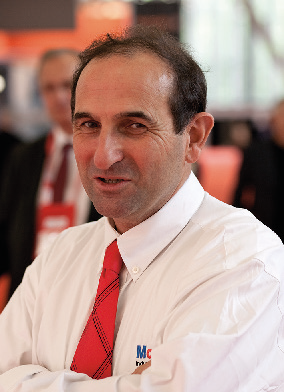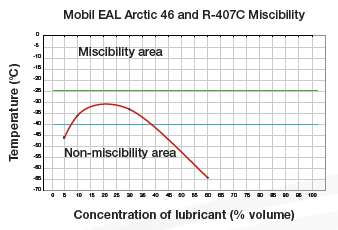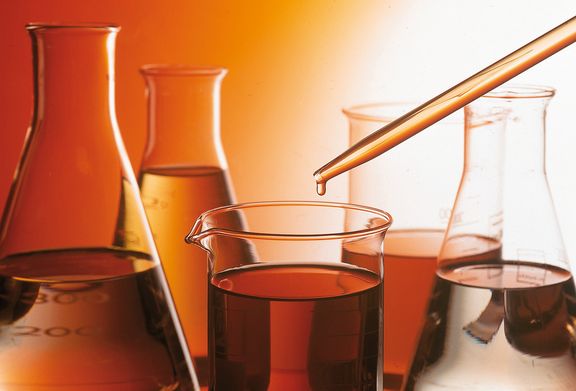Environmental concerns, upheld in particular by the Montreal and Kyoto protocols, have led to a change of technology in terms of refrigerants for refrigeration output by compression, which has had an impact on the choice of lubricants.
Gilles Delafargue, an expert in customer technical support for Europe, Africa & the Middle East at ExxonMobil, explained to us how synthetic lubricants can respond to changes in refrigeration output by compression and improve the energy efficiency of installations.
Mr Delafargue, could you share with us your vision of the changes to the refrigerant market?
G.D. : The Montreal Protocol (1989) has led to the gradual withdrawal of substances with a high Ozone Depletion Potential (ODP) and has had an impact on the use of ChloroFluoroCarbon type refrigerants (CFC- currently banned) and on that of HydroChloroFluoroCarbons (HCFC which are in the process of being withdrawn from use). The Kyoto protocol (1997) defined the targets for reducing greenhouse gases. These decisions have affected certain HydroFluoroCarbons (HFC) with a high Global Warming Potential (GWP) even though they do not attack the ozone layer, and have led to the development of HydroFluoroOlefins (HFO).
These changes to the legislation on environmental protection have indirectly brought about a return to the use of ammonia (NH3), carbon dioxide (CO2) and, to some extent, hydrocarbons (HC). The use of HCs remains confined to small household appliances but the promoters of HC continue with their wish to develop their use in larger installations such as industrial ice production machines, freezers or even chillers. HFCs are still very much with us, although their replacement by HFO type fluids with low GWP is going to increase. In Europe, we have seen the promotion of CO2 and then HFO-1234yf in the area of automotive air conditioning.
In the face of these changes, what criteria should be taken into account when choosing a lubricant?
G.D. : Most of the industrial refrigeration installations are compression systems, in which cooling is produced by the evaporation of a refrigerant such as a HFC, HFO, HC, ammonia or CO2. The nature of the refrigerant, the type of compressor and the temperature in the evaporator will determine the type of lubricant as well as its viscosity. In this respect, the miscibility and solubility of the refrigerant / lubricant mixture are key parameters to be considered.
Appropriate lubricant / refrigerant miscibility at the temperature of the evaporator is crucial for so-called “miscible” applications (systems without an oil separator). The refrigerant / oil mixture must remain homogeneous until the end of evaporation so that it can return to the compressor. If there is separation of the 2 components due to poor miscibility, the oil will be trapped in the evaporator, significantly deteriorating the efficiency of the refrigeration installation and / or affecting the correct operation of the compressor (low oil level). In the compressor, the high pressure and the high temperature will contribute to reducing the viscosity of the lubricant (linked to the solubility of the refrigerant in the oil). Viscosity that is too low will affect the protection against wear. The harmful effects of the reduction in viscosity can be avoided by selecting the appropriate type of oil and viscosity for the application.
ExxonMobil has established a large number of miscibility curves and “VPT” (Viscosity / Pressure / Temperature) curves in order to ensure that the selected lubricant corresponds to the miscibility and viscosity requirements of the application. Customers also benefit from technical support thanks to experts in the field or via the ExxonMobil European Technical Support Centre.
Which lubricants have you developed for use in refrigeration installations?
G.D. : ExxonMobil rigorously monitors changes to legislation and has been able to meet the environmental protection requirements by marketing high performance lubricants for applications with ammonia, HFOs or CO2. The Mobil EAL Arctic (“Environmental Awareness Lubricant”) synthetic lubricants have been specially developed for lubricating compressors and systems using HFC refrigerants. They are formulated from oils with a Polyolester (POE) type base and have notable properties in terms of lubrication, protection against wear and perfect chemical stability and remarkable resistance to thermal stress. Mobil EAL Arctic lubricants have miscibility compatible with HFCs and well defined Viscosity / Pressure / Temperature characteristics with a large number of HFC fluids.
Large scale installations, using ammonia (which is not very or not at all miscible with hydrocarbon lubricants) as the refrigerant, are fitted with oil separators. Thus, it is important to use a lubricant that is completely non-miscible with the refrigerant and with a low vapour pressure in order to avoid or minimise any oil being dragged into the circuit.
Mobil Gargoyle Arctic SHC 200 oils, which are formulated from oils with a PolyAlphaOlefin (PAO) type base, are recommended for lubricating refrigeration compressors operating at very high temperatures and low temperatures in the evaporator. Their solubility and miscibility with refrigerants is low and the result is the formation of thick films of oil in the presence of refrigerants under pressure, making it possible to minimise oil leaks in the compressor shaft seals. Their high level of resistance to shearing, their high viscosity level and their excellent fluidity at low temperature allow Mobil Gargoyle Arctic SHC 200 oils to guarantee high level performances for the harshest applications with ammonia.
Mobil Gargoyle Arctic SHC 200 oils can also be used to lubricate CO2 installations that are not or not very miscible. In addition, Mobil Gargoyle Arctic SHC 200 oils are NSF H1 registered and can therefore be used for incidental food contact applications.
Can the choice of lubricant have an impact on the energy efficiency of the installation?
G.D. : Numerous refrigeration installations now use ammonia as a refrigerant. The main lubricant technologies for ammonia-based applications are:
- Naphthenic Mineral (NM) and Paraffinic Mineral (PM) oil, refined from crude oil with Naphthenic or Paraffinic tendency.
- Synthetic oils formulated from PolyAlphaOlefin (PAO) bases or from mixtures with a PAO / AB (AlkylBenzene) base. A detailed study conducted in 2011 at the EMRE (ExxonMobil Research & Engineering) Research Centre in the USA, showed that PAO technology-based synthetic lubricants were potentially the best technical choice for ammonia-based applications compared to MN and MP technologies (major possibility of improving the efficiency of the installation, better characteristics at low temperatures, better control of movement of oil, excellent control of viscosity at high temperatures, better degassing characteristics).
Mobil Gargoyle Arctic SHC 200 oils, with PAO technology and paraffin-free, demonstrated remarkable performances in non-miscible applications for compressors for industrial use, in supermarkets or for heat pumps and specifically in ammonia-based applications. In addition, the study also showed that the low temperature viscosity of the PAO technology-based ExxonMobil oils is a lot lower than that of Naphtenic or Paraffinic Mineral technology-based oils. This makes it possible to considerably improve the installation by minimising the thickness of the insulating layer generated by the oil trapped in the evaporator and altering the efficiency of thermal exchanges. The results also confirmed that Mobil Gargoyle Arctic SHC 200 oils have excellent resistance to thermal stress and oxidation and excellent chemical stability thus allowing a potential increase in the period of use of the lubricant, extension of the drainage intervals, increase in the period of use of the filters and a reduction in the number of leaks from the compressor shaft seal.
By way of example, the use of Mobil Gargoyle Arctic SHC 226E allowed a major brewery in Poland to save €100,200 in 3 years. After the changeover to the synthetic lubricant (instead of the mineral oil that was being used), the intervals between drainage were multiplied by 6 (in other words, drainage every three years instead of two drainages per year) leading to a reduction in the costs of draining and maintaining the oil separator and the costs associated with processing the used oil. Furthermore, the compressor maintenance costs were reduced through excellent control of cleanliness.
In your opinion, what will the refrigeration output model be for the future?
Alternative technologies for refrigeration output, such as “Magnetic Refrigeration” are starting to appear on the market. “Magnetic Refrigeration” (energy saving process) generates refrigeration by changing the temperature of certain alloys when they are submitted to a magnetic field (“Magnetocaloric” effect) without the need to use expensive compressors or refrigerants. Two European companies recently announced their plans to launch, within two years from now, “magnetic refrigeration” technology systems for domestic installations. Nonetheless, traditional compression systems, accompanied by a changeover to low GWP refrigerants, will remain on the market.
To conclude, what would be your final recommendation?
G.D. : The running of an industrial refrigeration installation goes hand in hand with appropriate maintenance. Breakdowns or reductions in capacity of the installations can lead to significant losses of production or stored products. With the use of refrigerants such as ammonia, CO2 and HCs and the gradual replacement of HFCs with low-GWP HFO type fluids, the availability of high quality lubricants that meet environmental requirements becomes essential.
ExxonMobil has been able to respond to these changes by developing and offering a range of products available worldwide in order to meet tomorrow’s challenges, while continuing to supply recommendations and provide technical support for its customers.

GILLES DELAFARGUE, EXXONMOBIL
Expert in customer technical support.
Use of a miscibility curve

The red curve defines the areas of solubility between Mobil EAL Arctic 46 and R-407C refrigerant according to the concentration of lubricant in the mixture. Below this curve, we have 2 non-miscible phases. Above this curve, the lubricant and refrigerant form just one phase. Digital application: For a temperature of -25°C (green line), Mobil EAL Arctic 46 and the R-407C fluid form just one phase whatever the concentration of Mobil EAL Arctic 46. At -40°C (blue line): A single phase for concentrations of Mobil EAL 46 of less than 7.5%, 2 non-miscible phases for concentrations of Mobil EAL Arctic 46 of between 7.5 and 38%, a single phase above 38% Mobil EAL Arctic 46.
ExxonMobil and Mobil are registered trademarks belonging to Exxon Mobil Corporation or one of its subsidiaries including Esso S.A.F. which operates them in France. Esso S.A.F. A Limited Liability Company with capital of €98,667,521.70 Nanterre Trade and Companies Register No. 542 010 053 5/6 Place de l’iris 92400 Courbevoie.

